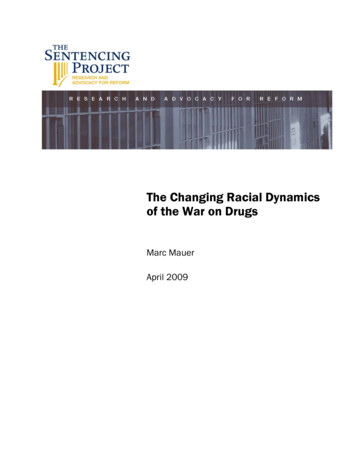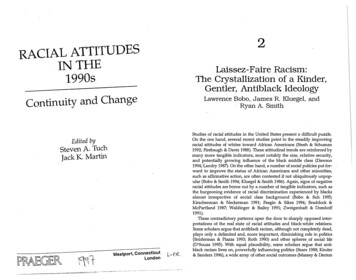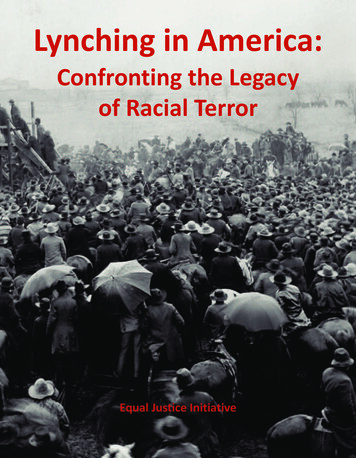
Transcription
The Changing Racial Dynamicsof the War on DrugsMarc MauerApril 2009
For further information:The Sentencing Project514 Tenth St. NWSuite 1000Washington, DC 20004(202) 628-0871This report was written by Marc Mauer, Executive Director, of TheSentencing Project. The author wishes to thank Katherine Beckett,Jonathan Caulkins, and William Sabol for helpful comments on adraft paper.The Sentencing Project is a national non-profit organization engagedin research and advocacy on criminal justice policy issues.The Sentencing Project is supported by the generosity of individualcontributors and the following foundations:www.sentencingproject.orgMorton K. and Jane Blaustein FoundationCriminal Justice Policy FoundationFord FoundationBernard F. and Alva B. Gimbel FoundationHerb Block FoundationJK Irwin FoundationRalph E. Ogden FoundationOpen Society InstitutePublic Welfare FoundationAnonymous Donor at Rockefeller Philanthropy AdvisorsElizabeth B. and Arthur E. Roswell FoundationSandler Family FoundationAnonymous Fund of Tides FoundationRestorative Justice Program, General Board of Global Ministries,United Methodist ChurchWallace Global FundCopyright 2009 by The Sentencing Project. Reproduction of thisdocument in full or part in print or electronic format only by permission ofThe Sentencing Project.
THE CHANGING RACIAL DYNAMICS OF THE WAR ON DRUGSOVERVIEWFor more than a quarter century the “war on drugs” has exerted a profound impacton the structure and scale of the criminal justice system. The inception of the “war”in the 1980s has been a major contributing factor to the historic rise in the prisonpopulation during this period. From a figure of about 40,000 people incarcerated inprison or jail for a drug offense in 1980, there has since been an 1100% increase to atotal of 500,000 today. To place some perspective on that change, the number ofpeople incarcerated for a drug offense is now greater than the number incarceratedfor all offenses in 1980.The increase in incarceration for drug offenses has been fueled by sharply escalatedlaw enforcement targeting of drug law violations, often accompanied by enhancedpenalties for such offenses. Many of the mandatory sentencing provisions adopted inboth state and federal law have been focused on drug offenses. At the federal level,the most notorious of these are the penalties for crack cocaine violations, wherebycrack offenses are punished far more severely than powder cocaine offenses, eventhough the two substances are pharmacologically identical. Despite changes infederal sentencing guidelines, the mandatory provisions still in place require thatanyone convicted of possessing as little as five grams of crack cocaine (the weight oftwo sugar packets) receive a five-year prison term for a first-time offense.At the state level, the most longstanding of the current generation of harsh drug lawsare New York’s “Rockefeller” drug laws. Adopted in 1973, these laws call for a 15year prison term for possession of four ounces of narcotics or sale of two ounces.Modest reforms to the law were enacted in 2004, and more substantial reform islikely to be signed into law this year.The dramatic escalation of incarceration for drug offenses has been accompanied byprofound racial/ethnic disparities. Overall, two-thirds of persons incarcerated for adrug offense in state prison are African American or Latino. These figures are far out
2THE CHANGING RACIAL DYNAMICS OF THE WAR ON DRUGSof proportion to the degree that these groups use or sell drugs. A wealth of researchdemonstrates that much of this disparity is fueled by disparate law enforcementpractices. 1 In effect, police agencies have frequently targeted drug law violations inlow-income communities of color for enforcement operations, while substance abusein communities with substantial resources is more likely to be addressed as a familyor public health problem.In recent years, there is emerging evidence of potentially significant change in theapproach and effects of national drug policy. First, there is increasing public andpolicymaker recognition of the value of drug treatment as a more appropriateresponse to substance abuse than incarceration in many instances. In this regard, wecan trace the rapid expansion of drug courts. From the inception of the firsttreatment-oriented courts in 1989, these programs have now grown to more than1,600 nationally. There is ongoing debate regarding the extent to which theseapproaches divert defendants from incarceration, but in any case they representbroad support for less punitive policies in regard to substance abuse.Within the prison system we have seen the beginnings of change as well. In stateprisons, from 1999-2005 (most recent data) there was virtually no change in thenumber of people incarcerated for a drug offense, rising less than 1% from 251,200to 253,5000 during this time. 2 Without exaggerating the impact of these figures –still record highs – there is nonetheless a stabilizing of these numbers in state prisons,a far different trend than was seen in the 1980s and early 1990s.1See, for example, Michael Tonry, Malign Neglect: Race, Crime, and Punishment in America, OxfordUniversity Press, New York, 1995; Katherine Beckett, Kris Nyrop, and Lori Pfingst, “Race, Drugs,and Policing: Understanding Disparities in Drug Delivery Arrests,” Criminology, 44, 1: 105-138.2All data on state prison populations taken from annual prison reports of the Bureau of JusticeStatistics.
3THE CHANGING RACIAL DYNAMICS OF THE WAR ON DRUGSThis stability in the number of drug offense incarcerations is intriguing, but hides aneven more dramatic change – a significant shift in the racial composition of peopleincarcerated for a drug offense. Our analysis below documents these striking trends: The number of African Americans in state prisons for a drug offense declinedby 21.6% from 1999-2005, a reduction of more than 31,000 persons. The number of whites incarcerated for a drug offense rose significantlyduring this period, an increase of 42.6%, representing an additional 21,000persons in prison.This report examines these shifting dynamics in the context of the criminal justicesystem to explore possible explanations for these changes. We then assess theimplications of these changes for both substance abuse policy and considerations ofracial justice.
4THE CHANGING RACIAL DYNAMICS OF THE WAR ON DRUGSCHANGING RACIAL DYNAMICS OF INCARCERATIONFOR DRUG OFFENSESSince the inception of the war on drugs, African American communities have beensubject to high levels of arrest and incarceration for drug offenses. As of 2005,African Americans represented 12% of the total population of drug users, but 34%of those arrested for drug offenses, and 45% of those in state prison for a drugoffense. Many of these disparate rates of supervision in the criminal justice systemstill persist, but within state prisons there is clearly a change taking place in recentyears. We can see this in Table 1 below, examining the number of personsincarcerated for a drug offense by race and ethnicity for 1999-2005.TABLE 1: DRUG OFFENDERS IN STATE PRISON BY RACE/ETHNICITY, ll 9,400253,3000.8%White #White 025.9%65,90026.4%72,30028.5%42.6%Black #Black 33,10053%112,50045.1%113,50044.8%-21.6%Hispanic #Hispanic 020%51,80020.8%51,10020.2%-1.9%
5THE CHANGING RACIAL DYNAMICS OF THE WAR ON DRUGSSeveral trends are striking in this period: First, the number of people serving prison time for a drug offense is virtuallyunchanged, increasing by less than 1% over the six-year time frame. Whilethis may not appear dramatic, it needs to be considered in the context of the1200% growth in the state prison population for drug offenses from 1980 to1999. Second, while the overall number of persons serving time for a drug offensehas not changed, the racial composition has shifted significantly. Thenumber of African Americans declined by more than 31,000 during thisperiod, a 21.6% drop. In 1999, African Americans had constituted 57.6% ofthose serving time in prison for a drug offense; by 2005 this figure haddeclined to 44.8%. 3 Conversely, the number of whites serving time for a drug offense rosesubstantially during this period, a 42.6% increase from 50,700 in 1999 to72,300 in 2005. As a result, the white share of drug offense incarcerationrose from 20.2% to 28.5%. The Hispanic figures were virtually unchangedduring this time, with a modest 1.9% drop overall. (Figures do not add to100 percent due to other race categories.)3Data analysis procedures adopted by the Bureau of Justice Statistics in 2004 affected thecategorization of persons identifying with two or more races (2.9% of the total), and had the result ofa modest reduction in the number of persons identified as non-Hispanic white and black.
6THE CHANGING RACIAL DYNAMICS OF THE WAR ON DRUGSASSESSING THE DECLINING BLACK PROPORTION OFDRUG OFFENSESIn looking at trends in state incarceration, clearly we are seeing the end result of 50state law enforcement and sentencing systems that cumulatively produce thesefigures. Therefore, one needs to be cautious about interpreting trends. But in orderto understand these dynamics we can look at a series of indicators to try to identifycausal factors, both within and outside the criminal justice system.Tradeoff with Federal Prison PopulationWe begin by looking at the composition of the federal prison population. A simpleexplanation for the declining black population in state prisons might be that federalprosecutors had enhanced drug prosecutions disproportionately among AfricanAmericans, and therefore merely shifted the location of imprisonment. Table 2below displays data on the racial/ethnic dynamics of incarceration in federal prisonsfor drug offenses from 1999-2005. 4TABLE 2: DRUG OFFENDERS IN FEDERAL PRISON BY RACE/ETHNICITY, ll 5,21132.7%White #White 3%21,17623.1%22,25123.4%34.9%Black #Black 142.9%39,35342.9%40,81242.9%31.2%Hispanic #Hispanic 2.5%29,49332.2%30,27931.8%31.1%4Data on federal prison population provided by the Federal Bureau of Prisons.
7THE CHANGING RACIAL DYNAMICS OF THE WAR ON DRUGSAs we can see, there was a significant increase – just under 10,000 – in the number ofAfrican Americans incarcerated for a drug offenses during this time. But this 31.2%increase was virtually identical to the increase for Latinos and slightly less than thatfor whites. This increase, therefore, represents an overall expansion of federalresources for drug prosecutions, but not one with enhanced differential effects onAfrican Americans. The only change of significance was a modest rise in 2001 whichincluded the absorption of incarcerated persons in the Washington, D.C. prisonsystem into the federal system, but the overall increased number of drug offenders ofall races from Washington, D.C. was just an additional 455 persons that year. So,there is no obvious change in the relative proportion of state and federalincarcerations that would explain the decline in the number of African Americans instate prisons for a drug offense.Rates of Drug UseA second area of inquiry relates to drug use. If, for example, African American druguse declined during this time period, then that might ultimately result in reducedincarceration for drug offenses. But as seen below in Table 3, there is little change inthis regard. Data on regular drug users, compiled by household surveys conductedby the Department of Health and Human Services, 5 has consistently shown overmany years that the number of drug users generally reflects the relative racial/ethnicproportion of the national population. That is, whites, blacks, and Latinos use drugsat relatively similar rates. African Americans constitute about 12% of the nationalpopulation, and from 1999-2005 comprised between 11.5-14.0% of all regular drugusers. Similar stability can be seen in the white and Hispanic proportions of drugusers during this time. So in this case as well, there are no changes that are5Data on rates of drug use from the national household surveys of the Substance Abuse and MentalHealth Services Administration of the Department of Health and Human Services. “Regular” drugusers are the most frequent consumers of drugs, as measured by “used drugs in the past month” in thesurveys. Even this measure, though, is somewhat imprecise, since it conflates people who use drugs ona daily basis with those who use drugs “regularly” but not daily. For these purposes, though, theoverall stability in rates of use is the most significant aspect of the analysis.
8THE CHANGING RACIAL DYNAMICS OF THE WAR ON DRUGSsignificant enough to explain the declining African American figures in stateimprisonment.TABLE 3: RACIAL/ETHNIC PROPORTION OF REGULAR DRUG USERS, 1999-2005YearWhite %Black %Hispanic 9.214.012.4It is important to note, though, that data on drug use are limited for two key reasons.First, it is much more likely that drug sellers, rather than users, will receive prisonsentences. But measuring drug selling is challenging, as there are no reliable surveysthat provide data. Persons who use drugs, though, generally report that theypurchased their drugs from someone of their own race. 6 Therefore, if drug use isroughly proportional to the overall population, drug selling rates are likely to be inthat range as well.A second limitation of using data on drug use is that it has been widely documentedthat drug arrests are far from responsive to actual rates of drug use. As a result of avariety of law enforcement policies and practices, people of color are far more likelyto be subject to drug arrests than are whites who use or sell drugs. Nonetheless, theavailable data at least convey that there are no changes in rates of drug use overallthat contribute to the prison data trends.6K. Jack Riley, Crack, Powder Cocaine, and Heroin: Drug Purchase and Use Patterns in Six U.S. Cities,National Institute of Justice, December 1997.
9THE CHANGING RACIAL DYNAMICS OF THE WAR ON DRUGSTrends in Arrest RatesFollowing the trajectory of the criminal justice system, we can then examine trends indrug arrest rates that might offer an explanation for the change in blackincarceration. Overall, we see in Table 4 that in the 1999-2005 period drug arrestscontinued to rise for all but one year, an overall increase of 19% during this time. 7This trend continues a pattern that has been virtually unabated since the mid-1980s.TABLE 4: DRUG ARRESTS, 1999-2005YearNumber of Drug 1,538,81320031,678,19220041,746,57020051,846,351In looking at the potential impact of drug arrests on incarceration, though, it isimportant to disaggregate the arrest totals. In recent years, there has been a sharpincrease in the number of arrests for marijuana offenses, which now total more than40% of all drug arrests. 8 The vast majority of marijuana arrests, more than 80%,have been for possession offenses. Since an arrest for marijuana possession rarelyresults in a prison term, it is more useful for these purposes to analyze arrest patternswithout these offenses, which lowers the arrest figures by nearly 40%.7Data on arrests taken from the annual Uniform Crime Reports of the FBI.8Ryan S. King and Marc Mauer, The War on Marijuana: The Transformation of the War on Drugs inthe 1990s, The Sentencing Project, May 2005.
10THE CHANGING RACIAL DYNAMICS OF THE WAR ON DRUGSIf we then examine drug arrests by race, excluding those for marijuana possession, wesee a significant shift. 9 As seen in Table 5 the proportion of adult African Americansarrested for one of these drug offenses declined from 40.1% in 1999 to 33.2% in2005, for an overall decline of 17.2% during this period. (FBI arrest data providebreakdowns by race, but not ethnicity. Therefore there is no means of trackingchanges for Latino arrestees, most of whom are incorporated in the white category.)The 17.2% decline in the black proportion of arrests approaches the scale of the21.6% decline in the number of African Americans in state prison for a drug offenseduring this period.TABLE 5: BLACK PROPORTION OF DRUG ARRESTS, EXCLUDING MARIJUANA POSSESSION,1999-20059YearBlack 00533.2Data calculated from drug arrest figures by race provided by the Uniform Crime Reports division ofthe FBI.
11THE CHANGING RACIAL DYNAMICS OF THE WAR ON DRUGSTrends in Drug Offense ConvictionsFollowing the changes in patterns of drug arrests we then examine data on felonydrug convictions by race. Data from the Bureau of Justice Statistics are analyzedevery two years, 10 as seen in Table 6. In this area, from 1998-2004 we can see asignificant decline in the black proportion of drug convictions, 13% overall (from53% to 46%) and 17% (from 57% to 47%) for drug trafficking offenses, which arethe drug charges most likely to result in a prison term. The decline in convictions fortrafficking offenses is almost identical to the proportional decline in drug arrests forAfrican Americans. All other things being equal, a declining proportion of blackdrug convictions should lead to similar reductions in black incarceration for drugoffenses. The decline in the conviction rate is not quite as large as the overall dropin incarceration for African Americans, but clearly represents a substantial portion ofthat change. (As with data on arrests, drug conviction data do not record ethnicity,so there is no means of tracking convictions for Latinos.)TABLE 6: PROPORTION OF DRUG CONVICTIONS BY RACE, 1998-200410WHITE1998200020022004All Drug Convictions46%46%55%52%Possession Convictions55%49%61%54%Trafficking Convictions42%44%51%51%BLACK1998200020022004All Drug Convictions53%53%43%46%Possession Convictions44%50%36%44%Trafficking Convictions57%55%47%47%See Felony Sentences in State Courts reports of the Bureau of Justice Statistics.
12THE CHANGING RACIAL DYNAMICS OF THE WAR ON DRUGSFACTORS CONTRIBUTING TO THE DECLINE INAFRICAN AMERICAN DRUG OFFENSEINCARCERATIONThe trends we are observing are relatively recent and therefore will need to beassessed over time in order to draw firm conclusions regarding the driving forcescontributing to the prison declines we have documented. But there are severalpossible systemic changes that may provide parts of the explanation.Changes in Drug Use PatternsWhile the overall racial distribution of drug users has not changed substantiallyduring this period, there have been some changes in the degree to which variousdrugs are used. In particular, the use of crack cocaine has declined substantially sincethe peak years of the late 1980s. An analysis published by the National Institute ofJustice documented that crack use had become much less popular, particularlyamong young people, by the 1990s. 11As has been true of other new drug phenomena over many years, the peak years ofthe crack cocaine “epidemic” were in retrospect relatively short-lived. As historianDavid Musto has documented, drug epidemics often begin with a new drugbecoming rapidly embraced by young people and others. 12 After a few years, thenovelty of the drug wears off and the harmful nature of the substance becomesincreasingly well understood. This generally results in a change in community normsto produce negative associations with the drug and hence, declining use amongpotential new initiates.11Andrew Golub and Bruce D. Johnson, The Rise of Marijuana as the Drug of Choice Among YouthfulAdult Arrestees, National Institute of Justice, June 2001.12David F. Musto, The American Disease: Origins of Narcotic Control, New York: Oxford UniversityPress, 1999.
13THE CHANGING RACIAL DYNAMICS OF THE WAR ON DRUGSChanges in Drug Selling PatternsAs use of crack cocaine was declining in the 1990s, so too were the methods of itssale in many cases. In criminologist Richard Curtis’s ethnographic studies inBrooklyn, N.Y., he found that by the late 1990s many drug sellers had shifted theirtransactions to indoor locations as well as limited their sales to people known tothem. 13 Regardless of the level of drug selling, such a shift had consequences forcommunities and the court system. During the early years of the war on drugs, lawenforcement activity had been heavily focused on urban crack markets. This was acontentious strategy. Police officials generally argued that the open-air drug marketsthat were common in many disadvantaged communities were disruptive tocommunity life and needed to be challenged. Civil rights advocates and otherscountered that the drug war was unfairly targeting drug activity in communities ofcolor, as well as underemphasizing approaches involving prevention and treatment.Regardless of which position one may have supported, the decline in crack use, alongwith changes in patterns of distribution, made it both more difficult and arguablyless necessary for law enforcement to exert such a heavy presence in thesecommunities.Changes in Arrest PatternsAs we have seen, there has been a steady decline in the black proportion of drugarrests (excluding marijuana possession) during the period 1999-2005.Unfortunately, FBI arrest data categories are too broad to permit an analysis ofchanges in arrest by specific type of drug, so there is no means by which to assesswhether changes in relative rates of use of crack cocaine or other drugs are drivingthese trends. But given the changes in rates of crack cocaine use and distributionpatterns we have observed, it seems likely that at least part of the declining AfricanAmerican share of drug arrests is related to these developments.13Richard Curtis, “The Improbable Transformation of Inner-City Neighborhoods: Crime, Violence,Drugs, and Youth in the 1990s,” Journal of Criminal Law and Criminology. Summer 1998, Vol. 88, 4.
14THE CHANGING RACIAL DYNAMICS OF THE WAR ON DRUGSImpact of Drug Courts or other Diversion ProgramsSince the inception of drug courts in 1989 there has been a broad expansion ofinterest and programming in this area. These courts vary significantly in many ways,including criteria for admission, type of treatment programming, and impact onsentencing. There remains debate regarding the degree to which these courts mayhave a “net-widening” effect; that is, do they divert people from a term ofincarceration or bring under court supervision people who might otherwise not beprocessed in the court system? There are not yet definitive findings in this regard,but it is likely that at least in some jurisdictions there are people charged with a drugoffense who are diverted from a prison term due to drug court programming.Whether such an outcome disproportionately benefits African Americans is in part afunction of the location of such diversion programs. To the extent that they arelocated in urban areas with heavy concentrations of people of color as defendants,this may be the case. In Brooklyn, New York, for example, the longstanding DrugTreatment Alternative to Prison program operated by the District Attorney’s officereports that 46% of its defendant population is African American and 46%Hispanic. 14 Scholars such as Michael O’Hear, though, contend that the eligibilitycriteria for drug court programs and length of prison terms for unsuccessfulparticipants may actually disadvantage African American defendants. 15Impact of Sentencing PoliciesThe 21.6% decline in the number of African Americans incarcerated for a drugoffense is clearly consistent with declines of that magnitude in the black rate of arrestand conviction during this period. In addition, to the extent that some portion ofthis decline was related to declining arrests for crack cocaine offenses, this factor mayhave contributed disproportionately to the decline. At the federal level there has14Drug Treatment Alternative to Prison, Seventeenth Annual Report, May 2008.15Micahel O’Hear, “Rethinking Drug Courts: Restorative Justice as a Response to Racial Injustice,”Stanford Law and Policy Review, Vol. 20, April 2009.
15THE CHANGING RACIAL DYNAMICS OF THE WAR ON DRUGSbeen a great deal of attention to the broad sentencing disparity between punishmentsfor crack cocaine compared to powder cocaine offenses. But 13 states also maintain adistinction in sentencing between the two drugs, albeit not as extreme as in thefederal system. 16 Therefore, to the extent that African Americans have beendisproportionately charged with crack cocaine offenses in the past, it is likely thattheir sentences in these states were more severe than for persons convicted of otherdrug charges.It is important to note as well that despite the apparent declining impact of crackcocaine on arrests and incarceration at the state level, there has been nocorresponding decline at the federal level. The number of federal prosecutions forcrack offenses remains substantial, and as we have seen, the overall number of peoplein federal prison for a drug offense rose by 32.7% from 1999 to 2005. Racialdisparities persist as well, with African Americans constituting more than 80% of thepeople convicted of a federal crack cocaine offense.16United States Sentencing Commission, Cocaine and Federal Sentencing Policy, May 2007, p. 98.
16THE CHANGING RACIAL DYNAMICS OF THE WAR ON DRUGSTHE RISING WHITE PROPORTION OF DRUG OFFENSEPRISON TERMSAs we have seen, the decline in black incarcerations for drug offenses has beenmatched by a substantial rise in whites behind bars for drug offenses. Several possibleexplanations may be at play in this regard.First, we have seen over time that drug offense arrest rates are largely a function oflaw enforcement practices, rather than absolute levels of drug use or selling. That is,police agencies have in many cases concentrated resources on stemming drug trafficin low-income communities of color. This is often justified by arguments that drugselling in such neighborhoods is more likely to be disruptive to the community dueto open-air drug markets and therefore requires a law enforcement response. Such anassertion is challenged by the argument that drug selling in many white communitiescan be harmful to individuals and families as well, and that a heavy emphasis on lawenforcement diverts resources from prevention and community-building services thatwould be more beneficial.Regardless of how one sees these issues, there is little doubt that law enforcementpractices for many years disproportionately targeted minority neighborhoods. But asnoted above regarding the changing composition of (non-marijuana possession) drugarrests, it is possible that whites are increasingly comprising a larger share of the drugarrests that are more likely to result in a prison term.Another possibility is that with the rise of methamphetamine in some states – a drugused more by whites and Latinos than African Americans – increasing prosecutionsand prison terms are contributing to the white rise in imprisonment. While there issome data to suggest that there are increasing numbers of persons serving prisonsentences for meth offenses, it is not clear what proportion of the overall increase isdue to this factor.
17THE CHANGING RACIAL DYNAMICS OF THE WAR ON DRUGSLooking at data from states with reported high rates of methamphetamine use, wefind some significant increases in imprisonment during the years covered in thisanalysis. In Minnesota, an analysis produced by the Department of Correctionsdocumented a substantial increase in the number of persons incarcerated for a methoffense, rising from 230 in 2001 to 1,127 in 2005, although there is no publisheddata on the racial composition of this population. 17 This increase accounted foralmost 90% of the growth of drug offense incarceration during this period.In Iowa, a state with reported significant rates of meth use, the growth inincarceration began prior to this time frame but continued throughout.Methamphetamine offenses as a proportion of drug admissions increased from 31%in 1995 to 68% by 2000, but then remained fairly steady through 2005 (66%),although the overall number of persons admitted for a drug offense continued torise. 18 Extrapolating data from the Iowa report suggests that meth offensesaccounted for about three-fourths of the 395 person rise in drug admissions for theperiod 1999-2005. Note, though, that admissions data are not necessarilyrepresentative of the offense distribution of persons incarcerated in prison, due todiffering lengths of stay for various offenses.While the data from these states lends support to the idea that increasedimprisonment for methamphetamine offenses is likely to have been responsible forsome portion of the overall white increase in incarceration, the relatively modestnumber of states with a significant methamphetamine-using population also suggeststhat it is probably not the only explanatory factor in this regard.As with the examination of African Americans in prison for a drug offense, assessingthe rise in the number of whites in prison is a complex undertaking and one thatreflects criminal justice processing in all 50 states. Gaining an understanding of these17Methamphetamine Offenders in Prison, Minnesota Department of Corrections, November 2005.18Iowa Prison Population Forecast, FY 2005-2015, Iowa Division of Criminal and Juvenile JusticePlanning, October 2005, p. 11.
18THE CHANGING RACIAL DYNAMICS OF THE WAR ON DRUGSdynamics will require a sustained examination in a vari
year prison term for possession of four ounces of narcotics or sale of two ounces. Modest reforms to the law were enacted in 2004, and more substantial reform is likely to be signed into law this year. The dramatic escalation of incarceration for drug offenses has been accompanied by profound racial/ethnic disparities.










